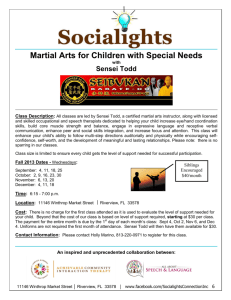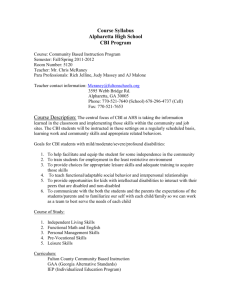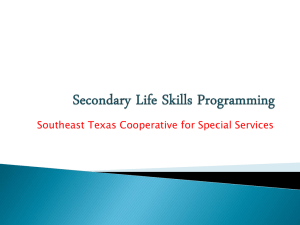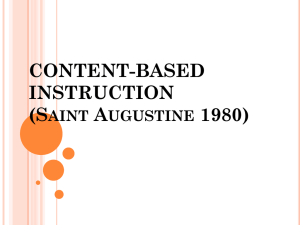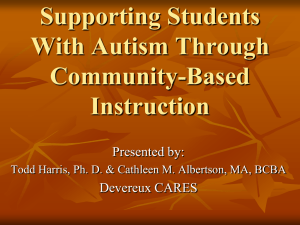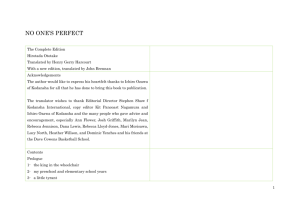Benkyoukai: Developing a Project in Content-Based
advertisement
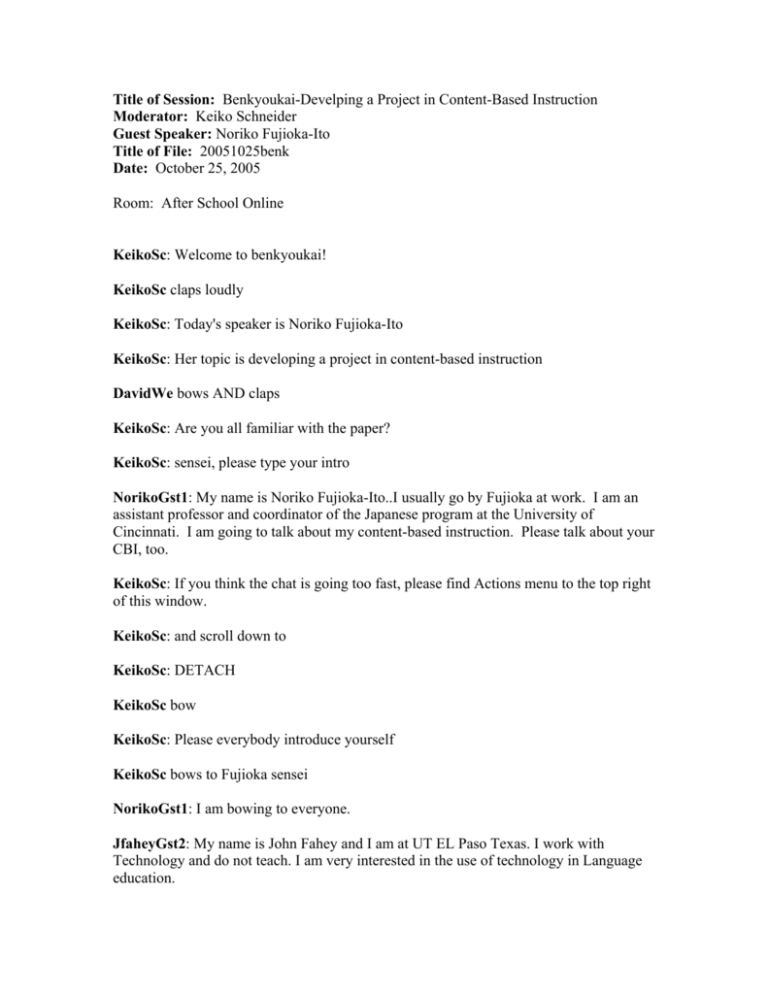
Title of Session: Benkyoukai-Develping a Project in Content-Based Instruction Moderator: Keiko Schneider Guest Speaker: Noriko Fujioka-Ito Title of File: 20051025benk Date: October 25, 2005 Room: After School Online KeikoSc: Welcome to benkyoukai! KeikoSc claps loudly KeikoSc: Today's speaker is Noriko Fujioka-Ito KeikoSc: Her topic is developing a project in content-based instruction DavidWe bows AND claps KeikoSc: Are you all familiar with the paper? KeikoSc: sensei, please type your intro NorikoGst1: My name is Noriko Fujioka-Ito..I usually go by Fujioka at work. I am an assistant professor and coordinator of the Japanese program at the University of Cincinnati. I am going to talk about my content-based instruction. Please talk about your CBI, too. KeikoSc: If you think the chat is going too fast, please find Actions menu to the top right of this window. KeikoSc: and scroll down to KeikoSc: DETACH KeikoSc bow KeikoSc: Please everybody introduce yourself KeikoSc bows to Fujioka sensei NorikoGst1: I am bowing to everyone. JfaheyGst2: My name is John Fahey and I am at UT EL Paso Texas. I work with Technology and do not teach. I am very interested in the use of technology in Language education. PhyllisGst6: I'm Phyllis Larson. I teach Japanese language and literature and film at St. Olaf College. KeikoSc: I am Keiko Schneider. The organizer of benkyoukai. I haven't done much of CBI myself, so I am all here to learn. I started to teach Japanese at SMU this fall. KeikoSc . o O ( everybody? ) KiyomiGst7: My name is Kiyomi Kagawa. I teach Japanese language at Tufts University. KazukoGst8: My name is Kazuko Ioroi. This is my first time participating in this benkyookai. I teach 1st and 3rd year Japanese classes at Michigan State University. Yososhiku Onegaishimasu. KeikoSc . o O ( what a wonderful group ) KeikoSc: Are you all familiar with Noriko sensei's paper? KeikoSc: Did you get to download and read? PhyllisGst6: yes KazukoGst8: yes JfaheyGst2: I am sorry I was only able to skim it quickly. KeikoSc: May I ask Noriko sensei to quickly refresh our mind, please? KeikoSc bows deeply NorikoGst1: I created the CBI using mainly Stoller and Grabe's Six-T's Approach. NorikoGst1: In my curriculum, this curriculum can maintain student motivations for learning. NorikoGst1: Actually, I have more students in my third-year class. NorikoGst1: Since this CBI has been integrated into the existing curriculum using a reading passage from IJ, I hope you will be able to refer to my CBI. KeikoSc . o O ( IJ? ) NorikoGst1: Has anyone developed CBI before? KeikoSc shakes her head NorikoGst1: IJ stands for "An Integrated Approach to Intermediate Japanese." JeffC joined the room. NorikoGst1: It is a textbook widely used. KeikoSc . o O ( Miura and McGloin? ) NorikoGst1: Yes. KeikoSc bows PhyllisGst6: I have worked with what I would have to call "modified" since it involved limited use of English and for students in a second-year class. NorikoGst1: Yes, it would be a little bit difficult for the students who are still learning basic grammatical items. NorikoGst1: However, some teachers must integrate CBI in the lower level curricula. NorikoGst1: Do you know anything about it? PhyllisGst6: Is it all right to ask questions? I don't have a copy of the text material Noriko refers to. How long a reading did you use? KeikoSc: http://www.sabotenweb.com/bookmarks/about/fujiokapaper.doc NorikoGst1: The only CBI I am using is just for my third-year-Japanese class and the International Coop Program. KeikoSc . o O ( in case you haven't downloaded ) NorikoGst1: The CBI I am currently using is just for my third-year-course and the International Coop Program. KeikoSc waves NorikoGst1: I cannot type in. PhyllisGst6: What I admired in your paper is the way in which you integrated every element so carefully. That's what takes so much time and care. I wonder if you have advice for us about how to set up a project like yours? NorikoGst1: Hello? KeikoSc: You are Ok, sensei KeikoSc: Noriko sensei is going to have to restart the computer KeikoSc: something is up KeikoSc growls NorikoGst1 left the room (signed off). KeikoSc: Larson sensei, I will show Noriko sensei our question again. JfaheyGst2: In the meantime could someone explain the 6Ts approach to a non teacher like me? PhyllisGst6: Thank you. KeikoSc also wanted to know PhyllisGst6: I'd like more information about the T7s, too. From Noriko's paper, it seemed the T7s were: theme, texts, topic, tasks, transitions, threads. But that doesn't tell us the idea behind it. PhyllisGst6: While we're waiting for Noriko--I think that approaching language learning from theme rather than grammar could be powerful. The concept is good. I think I have trouble working out a way of doing it well. KeikoSc nods solemnly KeikoSc: Larson sensei, as you said, careful planning is essential KeikoSc: far more work than following a book. JeffC: I have to run and wanted to drop in a link to an article I wrote which might jibe well with some of the ideas raised in the paper: http://www.netc.org/circuit/2004/spring/build.html KeikoSc: Great, Jeff. KeikoSc: Thank you. KeikoSc: That is a hyperlink by the way KeikoSc: You could click to view JeffC: I'll stay logged in but will be afk JeffC: Hold the Ctrl key down when clicking JeffC: Or allow popups from this site (best) JeffC: http://www.netc.org/circuit/2004/spring/build.html KeikoSc: sensei NorikoGst11 joined the room. BJB2 bows deeply to Noriko. Welcome back! KeikoSc claps KeikoSc: Here is the last comment from Larson sensei. KeikoSc: What I admired in your paper is the way in which you integrated every element so carefully. That's what takes so much time and care. I wonder if you have advice for us about how to set up a project like yours? NorikoGst11: Finally, I am back. I hope I did not miss much. KeikoSc: We were talking about what 6 Ts are NorikoGst11: Please take your time and decide a topic. NorikoGst11: I spent one and half years to make one-year-curriculum. NorikoGst11: However, it was integrated into the existing curriculum, so I did not change even textbooks. NorikoGst11: When I was just having my students read passages in the textbooks, I think my students must have thought just busy work. PhyllisGst6: I wonder if it would be possible to choose themes that would connect with ideas in other courses outside of the language ones? NorikoGst11: I think it is possible. You could invite another subject courses or people from the community. KazukoGst8: I think choosing a good topic for CBI is very important. I once taught 4th year Japanese using a history textbook for the secondary school, and some students weren't interested in the topic at all. KeikoSc . o O ( community ) NorikoGst11: Yes, selecting appropriate topics must be an important task. PhyllisGst6: Are there other themes you've developed? NorikoGst11: International Coop Program students write compositions about their work places using technical terms. NorikoGst11: That is a reinforcement of other disciplines through the foreign language. NorikoGst11: Phyllis-sensei. When you used CBI, what topic did you choose? KeikoSc . o O ( ah, nature of the program is quite specific ) NorikoGst11: Topic is an important using 6Ts, but I think Transitions and Threads were the difficult elements when I was outlining my CBI. PhyllisGst6: Well, I'm not expert, BUT I've worked with topics such as "virtues" where I used folktales that developed the idea of what good person is, or good child. You'll have to excuse my typing. NorikoGst11: They are difficult, but important to create larger curricular coherence. KeikoSc . o O ( no typing police around here. transcript will be edited ) NorikoGst11: Phyllis-sensei, did you use that topic for your second-year-course students? PhyllisGst6: The challenge I think about is how to help students work with ideas that connect with work students are doing in the rest of their lives. I'd like them to see how language helps them access ideas. Especially ideas that are important to them. KeikoSc nods solemnly PhyllisGst6: Oops. Now I'm behind. Here's the answer to the question. Yes, I did. NorikoGst11: Yes, you are right, but if you choose an extremely abstract topic, it would be hard to handle. PhyllisGst6: I seem to be saying too much. But I'd like to know how this CBI unit affected students' motivation and whether you noticed better (more long term?) learning as a result? If so, could you tell us in what ways? NorikoGst11: In my CBI, the unit I described in my paper links with three chapters. The linkages across one year. That means, students can create their projects reinforcing the skills obtained previously. NorikoGst11: That is the key to maintain student motivations using this kind of longer term curriculum. PhyllisGst6: Do you mean that linking is the key to the increased motivation? NorikoGst11: I noticed the students could develop speaking and writing abilities better after I started to use the CBI. NorikoGst11: Let me go back to your last question. Yes, because I explain the students about the projects for three quarters in fall. NorikoGst11: So, students can have some ideas of what they are going to do later. NorikoGst11: Also, they can clear feedback each time, so they know what aspects they should improve. PhyllisGst6: I think that's impressive. It requires a lot of planning. NorikoGst11: Assessment in CBI need to balance assessing the content with the language, so it was not easy to develop the rubrics. NorikoGst11: I started to develop the CBI for my third-year-course two summers ago, and I completed it last fall. NorikoGst11: Therefore, last academic year was the first time to use for the entire year. PhyllisGst6: How did you build on the rubrics you mention at rubistar? NorikoGst11: Yes, I referred to RubiStar, but I could not find any rubric I could use as it was. DavidWe listens NorikoGst11: I combined several examples and modified for my needs. NorikoGst11: On November 9, I will display the posters my students made last spring; actually, I will complete the CBI of last academic year then. PhyllisGst6: While you were gone, several of us were wondering what the 6T's are and why you found them useful. NorikoGst11: 6Ts consist of Theme, Texts, Topic, Tasks, Transition, and Threads. NorikoGst11: If you take a look at the Introduction of my paper, you will know how they work. KeikoSc looks at the watch KeikoSc: We are almost at the top of the hour and... KeikoSc: this is just about the time that I asked Noriko sensei to commit KeikoSc: Is there any final question by participants or... NorikoGst11: As I mentioned before, why I liked to use 6Ts was very useful to create larger curricular coherence. NorikoGst11: Ok, one more question. KeikoSc: Or final comment by Noriko sensei? NorikoGst11: Thank you very much for your participation. KeikoSc: Thank YOU so much for your wonderful paper and your contribution KeikoSc: Impressive work! KazukoGst8: Thank you! KeikoSc bows and claps NorikoGst11: Doomo Arigatoo Gozaimashita. KeikoSc: And thank you all for participating. KeikoSc: The transcript of this session will be posted in PDF form shortly JfaheyGst2: Thank You very much. PhyllisGst6: Thank you! NorikoGst11: Keiko-sensei, thank you very much for organizing this Benkyoukai. KeikoSc: And please feel free to keep discussing the topic on senseOnline list KeikoSc: Despite the technical problem, I think we had a good discussion. KeikoSc bows deeply PhyllisGst6: This was my first experience with a benkyokai, and I enjoyed it. KeikoSc: Thank you for your contribution, Larson sensei.
